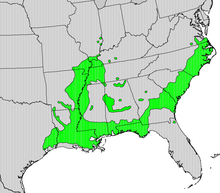Water tupelo tree
| Water tupelo tree | ||||||||||||
|---|---|---|---|---|---|---|---|---|---|---|---|---|

Water tupelo tree ( Nyssa aquatica ) |
||||||||||||
| Systematics | ||||||||||||
|
||||||||||||
| Scientific name | ||||||||||||
| Nyssa aquatica | ||||||||||||
| L. |
The water tupelo tree ( Nyssa aquatica ) is a species of the tupelo trees ( Nyssa ) within the dogwood family (Cornaceae).
description

Nyssa aquatica grows as a large, long-lived, up to 30 meters high, deciduous tree with a broad crown. The trunk diameter reaches over 1.2 meters. There are buttress roots or buttresses formed and the stem is swollen slightly at the base.
The alternate, simple, leathery leaves have short stems. The somewhat hairy petiole is up to 6 inches long. The pale green leaves, which are more or less fluffy hairy on the underside, are mostly entire or with isolated, distant and larger, sometimes pointed teeth. They are ovate to elliptical or obovate and about 8-20 inches long and 5-11 inches wide. At the tip they are pointed or pointed to pointed, rarely rounded, the leaf base is rounded or minimally heart-shaped to wedge-shaped. The stipules are missing. The young leaves are reddish and hairy.
Nyssa aquatica is polygamous and more precisely andro-polygamous, i.e. with male plants with only male flowers and female plants with hermaphrodite and functionally female flowers. The flowers appear axillary to the new drives, the smaller, almost sessile stalked male flowers in umbels or heads with two ciliated continue reading on hairy peduncle, larger, female and hermaphrodite appear individually on hairy stems. The greenish-white flowers are double- coated . The ring-shaped calyx is very small with minimal teeth. There are 5–10 early falling petals and one disc each. The male flowers with upright petals, with a small flower cup, have up to 10 protruding stamens with filamentous stamens, a pestle is usually missing. In the female or hermaphrodite flowers, with a long, tubed flower cups and with less or non-existent, enclosed stamens or staminodes with Antheroden, the uni-'s ovary inferior, projecting with a simple little and often rolled on top, tapered and solid pen . They are each underlaid by 2 to 4 elongated, long and hairy bracts .
Dark purple or bluish stems hanging down on longer stems often have slightly whitish dots, up to 3 centimeters in size, ellipsoidal to obscure narrow-oval, slightly leathery, smooth stone fruits ( false fruit ) with stylus remains at the tip and a sharp, ribbed, brownish stone core educated.
Occurrence
Nyssa aquatica is found in the southern US states of southeast Missouri , southern Illinois , Georgia , southwest Kentucky , Louisiana , eastern North Carolina , South Carolina , southeast Virginia , Mississippi , Tennessee , Texas , Alabama , Arkansas, and Florida .
Nyssa aquatica in the coastal plains in the southeastern United States and in the Mississippi Valley . The water tupelo tree grows in breaks and floodplains . The plant's root system is periodically submerged in water. Water tupelo trees often occur in pure stands.
Taxonomy
The first publication of Nyssa aquatica was by Carl von Linné . The specific epithet aquatica stands for the habitats by and in the water.
Common names
Common English names are: Water tupelo, Tupelo-gum, Water-gum Cottongum, Wild olive, Large tupelo.
One of the English trivial names "Tupelo" comes from the language of the Creek Indians and is composed of the words ito (for "tree") and opilwa (for "swamp"); it was in use until the middle of the 18th century.
use
Large, fully grown trees can provide commercially usable wood that is used to make furniture and boxes. The puffy base is popular for carving .
Many wild animals will eat the fruits and from the flowers costume is honey obtained.
literature
- Charles Sprague Sargent: Manual of the trees of North America. Second Edition, Hougthon Mifflin, 1922, 779-784, online biodiversitylibrary.org.
- Robert K. Godfrey: Trees, Shrubs, and Woody Vines of Northern Florida and Adjacent Georgia and Alabama. Univ. Georgia Press, 1988, ISBN 0-8203-1035-2 , pp. 490 ff.
- Robert H. Mohlenbrock: Nelumbonaceae to Vitaceae. SIU Press, 2010, ISBN 978-0-8093-2894-9 , p. 18 f.
- K. Kubitzki : The Families and Genera of Vascular Plants. Vol. VI: Flowering Plants Dicotyledons , Springer, 2004, ISBN 978-3-642-05714-4 (Reprint), p. 86 f.
Web links
- Nyssa aquatica at Southeastern Flora (pictures).
- Louisiana State University: Datasheet on Nyssa aquatica in the USA (English).
- Images of Nyssa aquatica at College of Arts and Science, Vanderbilt University.
- Everything about Tupelo wood on woodworkingnetwork.com (English).
Individual evidence
- ↑ a b c Nyssa aquatica in the Germplasm Resources Information Network (GRIN), USDA , ARS , National Genetic Resources Program. National Germplasm Resources Laboratory, Beltsville, Maryland. Retrieved September 3, 2019.
- ↑ Nyssa aquatica L. water tupelo . In: Plants Database . Unites States Department of Agriculture, Natural Resources Conservation Service. Retrieved July 4, 2019.
- ↑ Nyssa aquatica . In: Plant Database . Lady Bird Johnson Wildflower Center, The University of Texas at Austin. Retrieved July 4, 2019.
- ↑ a b c RL Johnson: Nyssa sylvatica Marsh. Black Tupelo . USDA , US Forest Service , Southern Research Station. Retrieved July 4, 2019.
- ^ LH Bailey, EZ Bailey, the staff of the Liberty Hyde Bailey Hortorium: Hortus third: A concise dictionary of plants cultivated in the United States and Canada . Macmillan, New York 1976, ISBN 978-0-02-505470-7 .
- ↑ Erin McKean (Ed.): New Oxford American Dictionary , 2nd edition.


